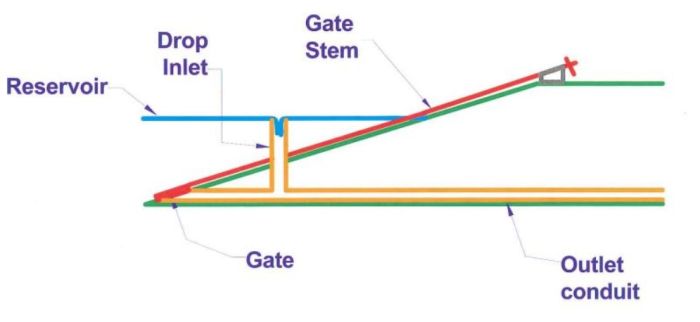Upstream Control: Difference between revisions
No edit summary |
No edit summary |
||
| Line 42: | Line 42: | ||
*[[Ice and Debris may cause Damage]] | *[[Ice and Debris may cause Damage]] | ||
''Note: The content on this page was originally created as part of DamOutletWorks.org (DOWL, 2018). It has subsequently been updated and reformatted as part of the Dam Safety Toolbox.'' | |||
[[Category:Example Pages]] | [[Category:Example Pages]] | ||
{{Revhistinf}} | {{Revhistinf}} | ||
Revision as of 20:48, 15 September 2022
Upstream Control with Sloping Gate
Dams with inclined gates are common on small dams. They provide easy access for the gate operator but can present maintenance difficulties. The gate is susceptible to blockage and can be dislodged from the guides. If maintenance is required, the reservoir has to be drained. The gate stem should be buried in riprap or encase in concrete.
A typical installation of an inclined slide gate:

Pros of Inclined Gate:
- Hydraulically efficient gate position
- "Spilled" water is conserved (in delivery system)
Cons of Inclined Gate:
- Gate stem must be buried to protect from damage
- Easy to damage by misoperation - operator must be careful not to bend stem
- Susceptible to clogging with debris - trash rack is important.
Sloping Gate Examples
Protecting the Gate
Upstream Control with Vertical Gate
Dams with vertical gates generally have the gate placed on the low-level pipe inlet or in a drop-inlet structure. Vertical gates are usually accessed by a walkway, are less expensive, and generally easier to install. Vertical gates located on a pipe inlet are only recommended on very small reservoirs, with gentle upstream slopes. On larger ponds, the gate stem and walkway are susceptible to damage from ice. In addition, if something happens to the walkway, the gate operator cannot be accessed at full pool. Vertical gates located in a drop-inlet tower have a reduced potential for ice damage and have easier access for repair. Ice can still damage towers, read further for more information.
Pros of Vertical Gate:
- Easy access to gate for operation
- Relatively easy installation
- "Spilled" water is conserved (in delivery system if drop inlet is present)
- Cost Effective
- Hydraulically efficient gate position
Cons of Vertical Gate:
- Stem and riser can be damaged by ice if not protected by tower
- If a drop inlet is not present, an auxiliary spillway designed to handle frequent flows is needed, often with high maintenance needs.
- Venting is required
Examples
Cautions
Note: The content on this page was originally created as part of DamOutletWorks.org (DOWL, 2018). It has subsequently been updated and reformatted as part of the Dam Safety Toolbox.
Revision ID: 3184
Revision Date: 09/15/2022



